Qigong – Tai Chi for Better Health and Life Energy
Qigong (Chi Kung) & Taiji (Tai Chi) are ancient forms of Chinese exercise practiced for over a millennia to increase health and longevity of life. The practice includes meditation, breathing exercises, focused intention and movements all designed to move the Qi, aka Vital Energy through the body. Practicing Qigong or Tai Chi is a very gentle yet powerful way to heal and strengthen your the mind, body and spirit. It is the ultimate in self-healing for preventive medicine and health. It’s also a lot of fun and makes you feel amazingly good!
Terry Hodgkinson Shifu learned Qigong and Tai Chi from teachers in three countries. Canada, India and China. Hodgkinson Shifu returns each year to study with his teachers from India and China. In China the study focuses on Taoist practice and Shifu leads group trips for all who are interested in training with his Chinese masters on Wudangshan, (Wudang Mountain).
What’s the Difference Between Qigong and Tai Chi?
Tai Chi and Qigong have in common the same basic focus called Qi (also known as Chi, Ki Prana etc), the same fundamental principle of relaxation, and the same fundamental method of slow and ease of movement with focused mental intent. In Tai Chi, Qi (energy) is used as mechanical energy. The opening of the meridians, meaning smooth circulation of Qi, allows one the unobstructed use of internal body mechanics through focused intent. Therefore, Tai Chi generally relates to the ‘energies’ of flowing physical movement, while Qigong’s focus relates more specifically to the ‘energies’ of organ function.
To sum it up, Tai Chi is generally more complex. T’ai chi forms involve a series of many moves. One T’ai Chi form can take months to learn and a lifetime to master. Qigong is often one single move repeated over and over, and sometimes does not involve movement at all, but will focus only on breathing.
Both are excellent, gentle practices for health and wellbeing.
Eight Silken Movements Brocade or Ba Duan Jin Qigong

Ba Dua Jin - Eight Silken Movements Brocade History
In 527, CE Buddhist patriarch Bodhidharma introduced the Eighteen Movements of the Lohan to monks at the Shaolin Temple when he saw that other exercises left the monks weak and sleepy during meditation. The first eight of these steps are the same as the Eight Section Brocade.
According to legend, in the Tang Dynasty 618-907, the Shaolin senior monk Ling Qiushan practiced Baduanjin qigong daily and lived to the age of 109. By the Song dynasty (960-1279), Baduanjin had continued its spread throughout China.
Baduanjin exercise is refered to in several encyclopaedias originating from the Song Dynasty. The Pivot of the Way (Dao Shi, c. 1150) describes an archaic form of this qigong and The Ten Compilations on Cultivating Perfection (Xiuzhen shi-shu, c. 1300) features illustrations of all eight movements and assigns the foundation of this exercise to two of the Eight Immortals, Zhongli Quan and Lu Dongbin.
During the Southern Song Dynasty in China 1177-1279, General Yeuh Fei created a set of twelve exercises to train to his men to help keep their bodies strong and well-prepared for battle. Eight of these 12 exercises were later practiced at a slower speed and became known as the Eight Section Brocade. The fact that he and his army were never defeated in battle was attributed to this training.
In 1973, archaeologists excavated the tomb of a noble who lived during the Western Han Dynasty 206 BCE- 24 CE in Hunan Province. Here they discovered alongside medical manuals a silk scroll featuring 44 drawings of humans in varying postures, each had a caption giving the name of the disease that the pose might help cure. These poses closely resemble poses in the Eight Silken Brocade.
Baduanjin qigong (八段錦), also known as Eight Silken Movemets Brocade or Eight Treasures, is one of the most common forms of Chinese qigong used as exercise. The name Baduanjin suggests a silky-smooth quality (similar to brocade) to the body’s movements and energy. Baduanjin is principally a form of Medical Qigong, used as way to improve and maintain the practitioners’ health and vitality.
Baduanjin consists of eight discrete exercises that focus on different physical areas and Qi meridians, with each of the movements repeated a number of times. Additionally, each of the movements may be practiced individually to reap the same health benefit. Baduanjin has standing and seated versions; however, the standing version is by far the most widely practiced.

Benefits of Practicing Ba Duan Jin Qigong
Basic Qigong Practice Principles
- Energy follows attention
Where we place our awareness, our conscious attention is where Chi also known as Qi, Ki, Pranayama or Vital-Force Energy will flow and gather.
- Mindful Breathing
Deep, mindful breathing grows and helps directs your vital energy. The physical breathing process is used to guide awareness into a union with life-force energy or “Qi.”
- Visualization/Mental Intent
Your visualization helps send your energy to the areas where it’s most needed.
The effectiveness of your Qigong will depend on the quality and regularity of your practice.
The Ba Duan Jin Qigong (Chi Kung) or the Eight Silken Movements Brocade Qigong is an ancient Chinese exercise routine involving using eight specific movements, stretching the muscles, squatting, martial arts aspects, deep breathing, concentration, and using one’s imagination. Qigong exercises are practiced daily to increase vitality, fortify the immune system, calm the spirit, improve flexibility, increase strength, enhance balance, open the energy (Qi or Chi) gates and pathways of the body, improve mood, and increase the chances for vibrant longevity. Below you will find the names of each movement followed by a description and more specific benefits for your health.
Pushing up Heaven Return to Centre
This move stimulates the “Triple Warmer” meridian (Sanjiao). It consists of an upward movement of the hands, which are loosely joined and travel up the center of the body and then return to the lower Dantian, also known as the centre of your body.
Drawing the Bow
While in a lower horse stance, you imitate the action of drawing a bow to either side. This movement exercises the waist area, focusing on the kidneys and spleen.
Connecting Heaven and Earth
This resembles a version of the first piece with the hands pressing in opposite directions, one up and one down. A smooth motion in which the hands switch positions is the main action, and especially stimulates the stomach.
Wise Owl Gazes Backwards
This is a stretch of the neck to the left and the right in an alternating fashion. This movement helps the lungs and neck.
Big Bear Turns from Side to Side
This movemet regulates the function of the heart and lungs. Its primary aim is to remove excess heat (or fire) (xin huo) from the heart. Xin huo is also associated with heart fire in traditional Chinese medicine. In performing this piece, you sink in a low horse stance, places the hands on thighs with the elbows facing out and twists to glance backwards on each side.
Two Hands Hold the Feet
This movement strengthens the Kidneys and Waist
This involves a stretch upwards followed by a forward bend and a holding of the toes.
Clench the Fists with Wide Eyes
This movement resembles the second one, and is largely a punching movement either to the sides or forward while in horse stance. This, which is the most external of the pieces, is aimed at increasing your vitality and muscular strength.
Bouncing on the Toes Shaking the Body
This is a push upward from the toes with a small rocking motion on landing. The gentle shaking vibrations of this piece is said to “smooth out” the Qi after practice of the preceding seven pieces. It also stimulates the flow of your lymphatic system helping remove toxins from your body faster.
Hodgkinson Shifu first learned Ba Duan Jin from his teacher Raj at International Meditation Centre in Pune, India almost 20 years ago and has been teaching it as part of his Chung Fu Martial Arts Meditation curriculum for 10 years now. Terry is often is called upon to teach at conferences and special events. Whether you wish to learn Ba Duan Jin in a group environment or through personal instruction, contact Terry Shifu and let him know and start enjoying the healthy benefits of this ancient practice.
Having been previously diagnosed with both depression and anxiety disorders, summarily prescribed every type of ‘medication’ you can imagine, Terry Hodgkinson encouraged me to discover ‘new’ solutions, based on ancient practices for developing a successful management strategy. I now have internal resources to draw on, and it has made all the difference.
Taoist Wudang Five Animals Qigong – Tai Chi
Wudang Mountain is the cradle of Wudang internal exercise Gung Fu (Kung Fu). Over hundreds of years Ancient Wudang Monks have developed this group of internal practices which combine physical fitness, internal work and martial arts.
Wudang Five Animal Qigong – Tai Chi is one of the most important exercises practiced by Wudang Taoists. Historically Wudang Taoists were required to practice these five forms daily. This practice is comprised of five major forms including Tortoise, Snake, Dragon, Tiger & Crane. This grouping of forms is derived from some of the most powerful and treasured creatures in traditional Chinese culture. Wudang Five Animals makes an excellent bridge for any student wanting to move from the more simplified, singular, movements of Qigong into slightly more complex, flowing movements of Tai Chi. Wudang Five Animals Forms make an excellent entry level for beginners into the of Tai Chi and yet still retain all the benefits of Qigong practice.
Wudang Qigong – Tai Chi can bring you great health benefits. When the five animals: tortoise, dragon, crane, tiger, and snake are practiced as a whole, one can obtain greater balance, flexibility, vigor, coordination, body awareness, blood circulation, organ health, and communication throughout the natural systems in the body. With time the practice can improve ones mental stability, as the training constantly strives to focus the minds energy and tame the disruptions caused by external distractions.
In each the Five Animals, the practitioner coordinates their breathing to match the push/pull energy of each movement. The flow of breath should always remain natural and relaxed, never forced or erratic. Posture is an important factor as well. Through this kind of training the body begins cleansing and revitalization. All in all, guiding the body and mind towards better health and longevity.
Click on the animal below to learn more
Tourtise Wudang Form
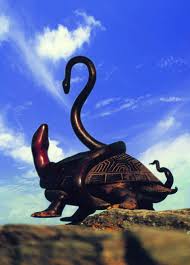 In Chinese traditional culture, the turtle is said to be able to predict the future, enjoy a long life, is very clever and does everything steady and quiet. In the five forms, the turtle belongs to the water element.
In Chinese traditional culture, the turtle is said to be able to predict the future, enjoy a long life, is very clever and does everything steady and quiet. In the five forms, the turtle belongs to the water element.
Practicing this form is said to increase energy, strengthen the kidney, and make the body soft and flexible.
- Starting position
- Guiding the breath into the lower Dantian aka Golden Stove area
- Having a deep and long breath
- Xian-Yu lifting up the ancient cooking vessel
- Crawling on the earth to look for the root
- The tortoise grasping the moon
- The tortoise playing with the water
- The tortoise spitting out the medicine
- Closing position
Dragon Wudang Form
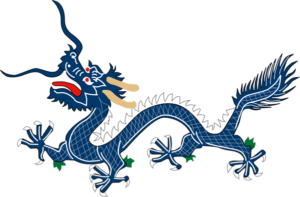 In Chinese traditional culture, the dragon is a creature of pure energy, creativity and wisdom that belonged to the clouds of heaven.
In Chinese traditional culture, the dragon is a creature of pure energy, creativity and wisdom that belonged to the clouds of heaven.
In the five elements, the dragon belongs to wood. Practicing this form is said to cultivate the liver and gallbladder and make the blood and breath vigorous.
- Starting position
- Guiding the breath into the the lower Dantian aka Golden Stove area
- The dragon extending claws
- The two dragons playing with the pearl
- The dragon waving the tail
- The dragon twisting to control the pearl
- The swimming dragon and the flying phoenix
- The dragon diving into the sea
- Closing position
Crane Wudang Form
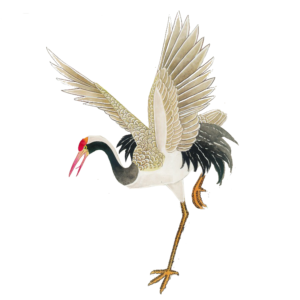 In Chinese traditional culture, the Crane represented the following attributes: Elegance, purity devotion and transcendence; the ability to leave the terrestrial realm and enter into the celestial one.
In Chinese traditional culture, the Crane represented the following attributes: Elegance, purity devotion and transcendence; the ability to leave the terrestrial realm and enter into the celestial one.
In the five elements, the crane belongs to fire; in the body, the heart. Practicing this regimen often can make a person vigorous in energy, wholesome and content in mind and mood.
- Starting position
- Guiding the breath into the lower Dantian aka Golden Stove area
- Flying to the left then to the right
- Crane displays wings
- Crane playing with the water
- Crane stands on the peak
- Crane ready to fly
- Crane cleaning eyes.
- Closing position
Tiger Wudang Form
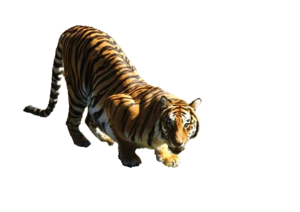 In Chinese traditional culture, the tiger is the symbol of power and spontaneity. In the five elements, the tiger belongs to earth.
In Chinese traditional culture, the tiger is the symbol of power and spontaneity. In the five elements, the tiger belongs to earth.
Practicing the form is said to cultivate the spleen and stomach and strengthen the bones and muscles.
- Starting position
- Guarding the breath into the lower Dantian aka Golden Stove area
- Tiger washes hands and face
- Tiger crouches down and observes
- Tiger attacks it’s prey
- Tiger standing and guarding it’s catch
- Tiger devours prey
- The tiger turning back the head
- Closing position
Snake Wudang Form
 In Chinese traditional culture, the snake and the tortoise were a unity, called Xuanwu. In the five elements, the snake belongs to metal; in the human body, the lung.
In Chinese traditional culture, the snake and the tortoise were a unity, called Xuanwu. In the five elements, the snake belongs to metal; in the human body, the lung.
Practicing this form is said to cultivate the lung and make the body soft.
- Starting position
- Guarding the breath into the lower Dantian aka Golden Stove area
- Turning around the body
- Snake twisting the willow
- Snake moving out of the den
- Snake moving into the den
- The snake moves along ground
- Snake turns over
- Closing position
Tai Chi Yang Style 24 Form
Yang Tai Chi 24 Movement Form was the result of an effort by the Chinese Sports Committee, which, in 1956, brought together four Taiji teachers – Chu Guiting, Cai Longyun, Fu Zhongwen, and Zhang Yu – to create a simplified form of Taiji as exercise for the masses. The creators truncated the traditional family style Taiji forms to 24 postures; taking about six minutes to perform and to give the beginner an introduction to the essential elements of Taijiquan, yet retain the traditional flavor of traditional longer hand forms that typically has 108 postures.
Originally Chen Chang Xing (1771-1853) developed the Chen Style T’ai Chi Ch’uan (Taijiquan) Old Frame Routine. He taught the Chen Style Taijiquan to Yang Lu Chan (1799-1872), who developed the Yang Style of Taijiquan. His grandson Chan, Yang Cheng Fu (1883-1936) modified and popularized the Yang Style Taijiquan, and published a number of books on the subject in the 1930’s
In 1956 the Chinese Sports Committee of the People’s Republic of China brought together four Taiji teachers – Chu Guiting, Cai Longyun, Fu Zhongwen, and Zhang Yu – to create a simplified form of Taiji as exercise for the masses. The creators truncated the traditional family style Taiji forms to 24 postures; taking about six minutes to perform and to give the beginner an introduction to the essential elements of Taijiquan, yet retain the traditional flavor of traditional longer hand forms that typically has 108 postures.
The 24 Taijiquan Form can be performed in 4 to 8 minutes, and consists, as would be expected, of 24 movements, although some of the movements have two or three parts.
Click below to learn more
Qualaties and Benefits Practicing Each of the 24 Yang Style Movements
TAI CHI CHUAN 24 FORM NAME OF MOVEMENTS |
WHAT INTERNAL ORGAN DOES THIS MOVE HELP? |
YIN/ YANG |
HAND/ FOOT |
5 ELEMENTS |
HOURS OF ACTIVATION |
1. Begin Tai Chi: salutation, raise and lower hands |
Stomach |
Yang |
Foot |
Earth |
7-9 PM |
2. Parting the wild horse’s mane (3 times) |
Small intestine |
Yang |
Hand |
Fire |
1-3 PM |
3. White crane displays wings |
Heart |
Yin |
Hand |
Fire |
11 AM-1 PM |
4. Brushing the knees and stepping (3 times) |
Large intestine |
Yang |
Hand |
Metal |
5-7 AM |
5. Play the guitar |
Liver |
Yin |
Foot |
Wood |
1-3 AM |
6. Step back and repulse monkey (4 times) |
Lungs |
Yin |
Hand |
Metal |
3-5 AM |
7. Grasping the bird’s tail on the left |
Pericardium |
Yin |
Hand |
Fire |
7-9 PM |
8. Grasping the bird’s tail on the right |
Pericardium |
Yin |
Hand |
Fire |
7-9 PM |
9. Simple whip |
Heart |
Yin |
Hand |
Fire |
11 AM-1 PM |
10. Waving hands like clouds (3 times) |
Triple heater |
Yand |
Hand |
Fire |
9-11 PM |
11. Simple whip |
Heart |
Yin |
Hand |
Fire |
11 AM-1 PM |
12. Patting the horse’s neck |
Small intestine |
Yang |
Hand |
Fire |
1-3 PM |
13. Right heel kick |
Liver |
Yin |
Foot |
Wood |
1-3 AM |
14. Double strikes against ears |
Lungs |
Yin |
Hand |
Metal |
3-5 AM |
15. Turn the body and left heel kick |
Spleen |
Yin |
Foot |
Earth |
9-11 AM |
16. Snake creeps down left leg, stand on one leg |
Kidney |
Yin |
Foot |
Water |
5-7 PM |
17. Snake creeps down right leg, stand on one leg |
Kidney |
Yin |
Foot |
Water |
5-7 PM |
18. Fair lady works the shuttle (right and left) |
Urinary bladder |
Yang |
Foot |
Water |
3-5 PM |
19. Pick up the needle from the bottom of the sea |
Gall bladder |
Yang |
Foot |
Wood |
11 PM – 1 AM |
20. Fend off and push away with arms |
Spleen |
Yin |
Foot |
Earth |
9-11 AM |
21. Turing around, warding off, punching |
Kidney |
Yin |
Foot |
Water |
5-7 PM |
22. Withdraw and push |
Small intestine |
Yang |
Hand |
Fire |
1-3 PM |
23. Crossing your hands |
Large intestine |
Yang |
Hand |
Metal |
5-7 AM |
24.Closing posture: Finish |
Stomach |
Yang |
Foot |
Earth |
7-9 PM |
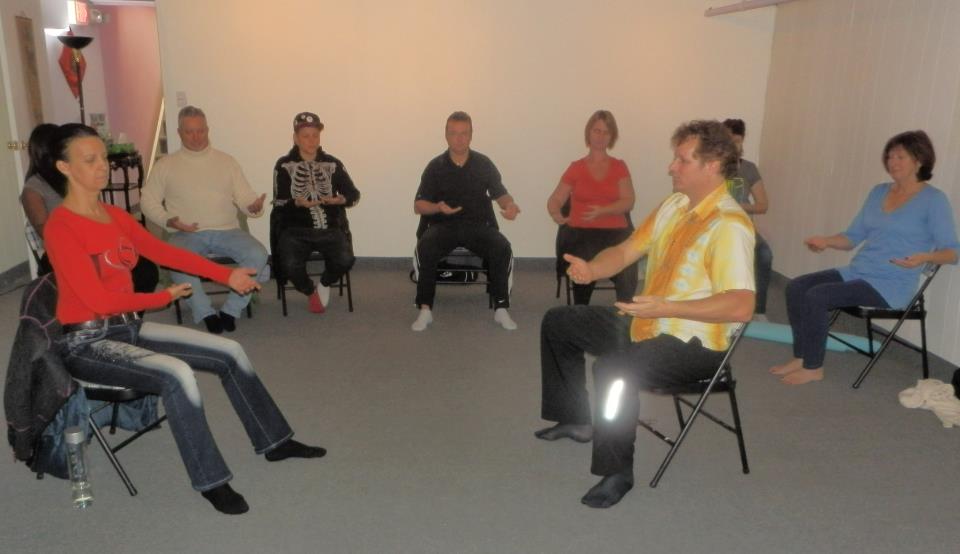
“The spirit is something to be enjoyed. It is not a harsh discipline. And I think people should take some time everyday for some kind of moving meditation, like Qigong or Tai Chi.” ~ Shirley Maclaine
Contact Terry for information or ask him how you can start practicing Qigong/Tai Chi today
Terry I totally loved your workshop today. You bring an awesome perspective into it with the wisdom that you have gained from your martial arts background and the knowledge that you have acquired from your incredible mystical journeys all over the world. By teaching a variety of different meditations you allow, the body and mind to fully relax. It also appeals to different personality gifts and learning styles.
When I met Terry Hodgkinson in the mid 90’s, I knew there was something special about him. At first I couldn’t put my finger on it. I had met superb martial artists before and encountered dozens of talented therapists, but with Terry there was something more. As we became close business associates and friends, I realized what it was; Terry is authentic. In the world of self-help, there seems to be a new guru or an acclaimed breakthrough every week, but most of these fall short in substance and method. In Terry I found the real deal. He had walked the walk.
